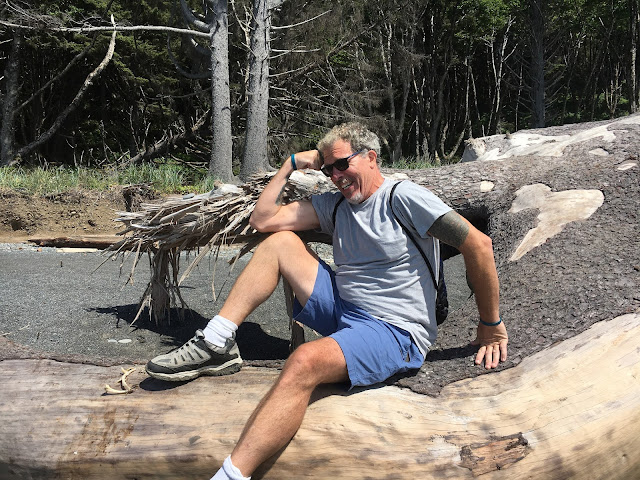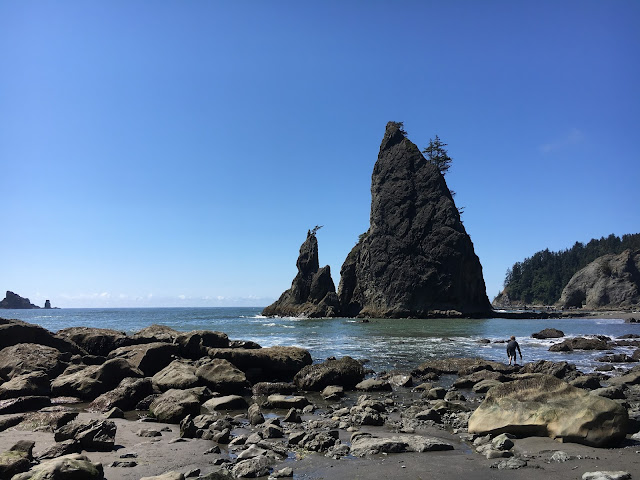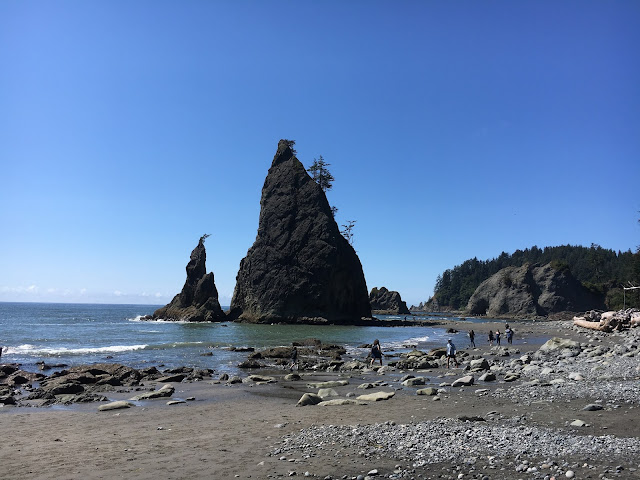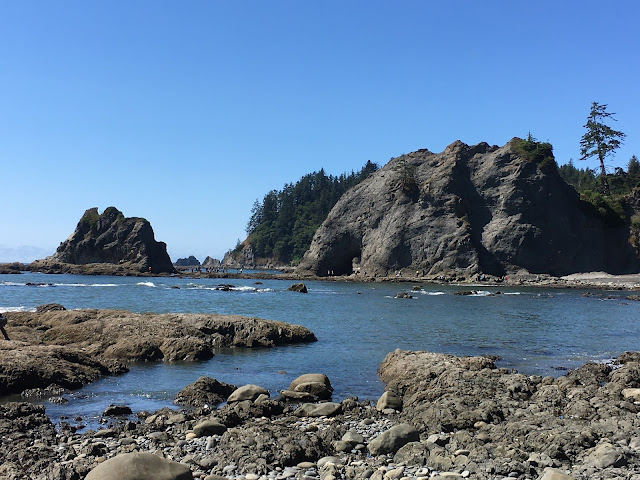On our second full day at Olympic National Park, we scheduled our one and only company tour. (We planned all the other day hikes and trips inside the park by ourselves.)
After reading through a list of guided tours in Olympic, I finally settled on using the Olympic Hiking Company as they had received numerous positive reviews on Viator and Trip Advisor. In particular, their 8-hour tour of the Hoh Rain Forest and Rialto Beach really caught my eye as I figured we could learn so much more about this unique rainforest from an actual tour instead of just wandering around with a map.
After we met the van at our designated pick-up spot, we were off to see the Hoh (pronounced 'Hoe') Rain Forest, which is touted for its huge trees and rich biodiversity. As mentioned before, there are 18 unique animals in the park that are found nowhere else in the world--most of them in the rainforest. The spectacular trees include the western red cedar (which has leaves that look like lace) and the western hemlock, which can tower up to 200 feet. The Sitka spruce and Douglas-firs can reach up to 300 feet!!
On the drive to the Hoh Rain Forest, we learned that this area of the park receives up to 140 inches (or about 12 feet) of rainfall annually. Part of the reason is due to the Olympic Mountain Range. Since saturated clouds cannot pass over the mountains, they must release their moisture (i.e. rain) before continuing their journey. As a result, since the clouds release all their rain in this one area, the land on the other side of the mountain range is dry (which is described as the high desert).
The Hoh River that passes through the Hoh Rainforest is fed by glaciers. The week before we started our trip, the state of Washington experienced one of its worst heatwaves in history with temperatures rising above 100 degrees. (Their normal for this time of year is around 70 degrees.) Our guide explained that the 100+ degree heat caused many of the glaciers to melt faster, which meant, in turn, that the water level of this river was really high. Thankfully, by the time we came, the heatwave had broke, and mostly everything, including the river, returned back to normal.
 |
| The moss and algae on the river were a beautiful bright green, but the water itself was crystal clear. |
 |
Our guide showed us this banana slug, which cannot be found anywhere else in the world.
(It turns different shades of green and yellow, just like a banana.) |
One of the hikes we took at the Hoh Rainforest was called the "Hall of Mosses," a 0.8 mile loop of lush, mossy tree groves. (It was enchanting!) During the hike, we learned that when a tree falls it becomes a nurse log.
Allie Wisniewski in American Forests explains a nurse log this way: "Even though they're dead, they are not gone...as they decay, nurse logs offer seedlings shade, nutrients, water, and protection from disease and pathogens; thus nurturing and making way for the new generation."
Here are a few examples of nurse trees and nurse logs our guide showed us where the trees actually grow out of other trees or out from these logs:



The next part of our tour was visiting Rialto Beach--the only beach we saw during our stay. Before I share pictures, let me say that this was the one part of our trip that was cut short. Literature on Olympic National Park will suggest that visitors see more than one beach, with favorites being Mora, Kalaloch, and Ruby Beach (in addition to Rialto Beach). For one, these beaches are known for their tidepools, which appear during low tide. Such pools contain colorful sealife, including brittle stars, hermit crabs, anemones, and octopuses. My Lake Quinault Lodge book by Smith-Western Co. states, "There are 29 species of marine mammals in the Olympic Coast Nation Marine Sanctuary...It also contains one of the largest populations of bald eagles and seabirds in the lower 48 states."
The other unique features of these beaches are the eerie sea stacks, described as "remnants of eroded coastal cliffs that loom out of the water" and the massive driftwood logs scattered along the Pacific Coast. The Lake Quinault Lodge book by Smith-Western Co. says, "More driftwood washes up on these beaches than anywhere else in the world. Trees are washed down from the rivers on the beach."
While we didn't get a chance to see the tidepools (which look just as enchanting as the Hoh Rain Forest), we did get to see the sea stacks, the driftwood, and a bald eagle nest (perched on top of one of the sea stacks). The beach, too, made up of all types of sand and stone, was miraculous.
 |
| There was a bald eagle family/nest on top of this sea stack. |
Indeed, our 8-hour tour felt more like 2 hours since we were having so much fun learning and sightseeing. This day was one of the most majestic parts of our trip, and yet, in the next three days, we would hike to two prominent waterfalls, drive 18 miles (or 5,000+ feet high) to see Hurricane Ridge, and spend our evenings soaking in 103-degree hot springs. In other words, there would still be way more to come.






























































The landscape is so interesting there!
ReplyDeleteDefinitely. I agree!!
Delete